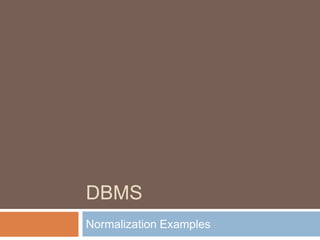
09.02 normalization example
- 2. Example 1 Album Tracks Artist ArtistCountry Abby Road Here comes the sun, Octopus Garden, Something, etc. Beatles UK Blond on Blond Rainy Day Woman, Sad eyed lady of the lowlands, Stuck in Memphis with the mobile blues again Bob Dylan US
- 3. This table could potentially fall prey to all three anomalies. If the ArtistCountry was required, it would be impossible to insert a new album if you did not know the country of the artist. If you deleted an album, you could accidently remove all data about a given artist. Updating tracks could be difficult and result in errors because of the way they are listed in the cell.
- 4. Converting a spreadsheet into a relational database is a common task for database developers. The task is not as straightforward as it might seem. Although you can often import data from a spread-sheet directly into a database management system, spreadsheets are almost never well designed for relational databases
- 5. First Normal Form The First Normal Form [FN1] involves getting rid of repeating groups or arrays. Each attribute should contain only a single value of a single type. This means a couple of things. For one, all the values under an attribute should be about the same thing. An attribute called ―Email,‖ for instance, should contain emails only, no phone or pager numbers. A second meaning is that each value stored under an attribute should be a single value, not an array or list of values. It would be wrong, for example, to store two or three emails for the same person separated by commas. An entity is in First Normal Form if
- 6. An entity is in First Normal Form if Every attribute represents only one value. There are no repeating groups or arrays. Each row is unique.
- 7. This Album table does not meet the criteria for First Normal Form. The main problem is in theTrack column. The columnTrackcontains a list of songs rather than a single value. This would make it very difficult to locate information about any single song. One solution that often occurs to novice database developers is to enumerate a list of columns such as Track1, Track2, Track3, and so on, to some arbitrary number of tracks. This also violates the First Normal Form by creating a repeating group. Say, for argument’s sake, you made 13 track columns. What happens to an album with fourteen tracks? What if an album has only one or two tracks? Also consider what you would need to do to find any individual track. You would need to query 13 separate columns
- 8. Table in First Normal Form AlbumTitle Track Artist ArtistCountr y Abby Road Here comes the sun Beatles UK Abby Road Octopus’s Garden Beatles UK Abby Road Something Beatles UK Blond on Blond Rainy Day Woman Bob Dylan US Blond on Blond Sad Eyed Lady of the lowlands Bob Dylan US Blond on Blond Stuck in Mobile with the Memphis blues again Bob Dylan US First Normal Form is not sufficient. Every column contains a single value, and there are no arrays or repeating groups, but there is a great deal of redundancy.
- 9. In the Album table, there are really at least two large subjects. One is the Album itself. The other is the Track. The Artist information depends on the Track. (Think about an album with tracks by multiple artists.) To conform to the Second Normal Form, the two functional dependencies—big themes—must be broken into separate entities.
- 10. To relate the Album entity to the Track entity, it is necessary to create a primary key for the Album entity that can be used to create a key– foreign key relationship with the Track entity. It is also a good idea to give the Track entity a primary key. Here is what the tables look like now: AlbumKey AlbumTitle ABRD Abby Road BLBLB Blond On Blond
- 11. TrackK ey Track AlbumKe y Artist ArtistCountr y HCTS Here comes the sun ABRD Beatles UK OPGD Octopus’s Garden ABRD Beatles UK SMTH Something ABRD Beatles UK RDWM Rainy Day Woman BLBL Bob Dylan US SELL Sad Eyed Lady of the lowlands BLBL Bob Dylan US SMMB Stuck in Mobile with the Memphis blues again BLBL Bob Dylan US
- 12. Third Normal Form For an entity to be in Third Normal Form, it has to first be in Second Normal Form. Third Normal Form is about removing “transitive dependencies.” A transitive dependency describes an attribute that depends on another attribute—not the primary key—for its eaning. The idea is that every attribute should directly describe the entity itself. If you have a Customer entity, every attribute should describe the customer. There shouldn’t be any attributes that describe another attribute. While transitive dependencies may seem trivial, they do add to redundancy and therefore open the possibilities for update and other anomalies.
- 13. There is a transitive dependency in the table. ArtistCountry doesn’t describe the track; it describes the Artist. The solution, as usual, is to break out a separate table. Artist should be its own entity. AlbumKey AlbumTitle ABRD Abby Road BLBLB Blond On Blond ArtistKey ArtistName ArtistCount ry BTLS Beatles UK BDLN Bob Dylan US ArtistAlbum
- 14. Track-Table 3NF Track Key Track Album Key Artist Key HCTS Here comes the sun ABRD BTLS OPG D Octopus’s Garden ABRD BTLS SMT H Something ABRD BTLS RDW M Rainy Day Woman BLBL BDLN SELL Sad Eyed Lady of the lowlands BLBL BDLN SMM B Stuck in Mobile with the Memphis BLBL BDLN
